Disclaimer: Vevor sent this product to us for free for a review. That does not affect our opinion about the product. In this article, we list both what we like and dislike. Read more about this here.
Is The Vevor 2500W Inverter Reliable Or Should You Spend More Money On An Inverter?
In this article I am going to review the Vevor 2500W power inverter. I have been testing it for a couple of weeks now, both with my lithium and deep-cycle batteries.
I have to say that I went into this review with a lot of skepticism. The biggest reason for that is because of how cheap it is. It only costs $186.99 over at Vevor.com.
I also want to clarify that I am not an electrician, and I don’t have a lot of experience with power inverters like this.
What I will share with you in this review is how it has performed over a few weeks, but also some things to consider before buying it.
Related Post: Vevor All-In-One Diesel Heater Review
Sure, there are other similar inverters on the market under $200, but buying one of them is often a huge gamble. You often get what you pay for.
That’s why I wanted to really test this one from Vevor before I shared my opinions on it. Does it work at all? Is it as powerful as they advertise? Did it explode?
To answer those questions, let’s start by looking at what Vevor says, and then what I have to say.
The Specifications
Power Output And Surge Watts
The Vevor 2500W is rated for up to 2500W. This is what it’s supposed to output steadily.
Since it’s a pure sine wave inverter, it’s safe to power any type of tool or appliance with. I tested to make sure it put out a pure sine wave.
Its surge watt rating is 5000W, and this is how much it can output for a short period.
You should never rely on the surge watts to power your devices, in my opinion.
It can be helpful if you have an air conditioner that uses between 2500-3000W for a couple of seconds, but I recommend buying a larger inverter instead.
An inverter is not 100% efficient as it changes DC to AC. Vevor advertises their 2500W model has a greater than or equal to 88% efficiency rate.
That’s good to know if you’re estimating what size battery you need for your setup and needs.
If I need to power a device that draws 10A for 10 hours a day with this inverter, I know that a 100Ah battery will not be large enough since I will lose roughly 12Ah during the DC to AC conversion.
Output Ports
There are three AC outlets and one USB A port on the same end as the power button and display.
The three AC outlets can output up to 2500W in total.
With the USB A port, you can plug in any device capable of charging via a USB cable. Like your phone, tablet, and rechargeable camping gear.
The USB port is a QC3.0 port capable of outputting up to 18W with compatible devices.
Display
Next to the ports, you will find the display that tells us what and how the inverter is doing.
It shows what the input voltage from the battery is, and what AC voltage it’s outputting.
There is also an output watt meter, which makes it easy to track how many watts you’re pulling from the battery. This is an estimate that should be taken with a grain of salt.
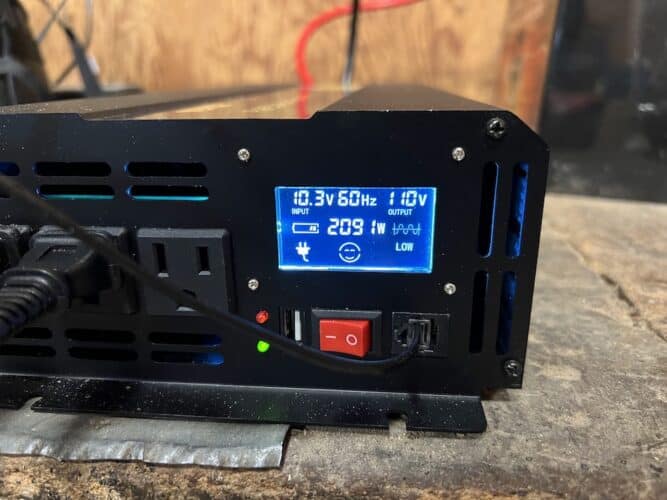
It’s important to know how many amps the inverter is drawing from the battery, especially with batteries that have a maximum continuous amperage that equals less than 2500W.
For example, my Power Queen 12V 100Ah lithium battery has a maximum output current rating of 100A. Anything above that, and the BMS turns off the output.
100A at 12.8V is 1280W, which is a little more than half of what the Vevor 2500W inverter can output.
Therefore, I should not plug in devices that require 1280W or more, even though the inverter is rated at 2500W.
Remote Controller
The included remote controller plugs into the inverter with an included 10 feet cable.
If the inverter is placed by the house battery or in the storage compartment an RV, I suggest making a way for the wire and the remote to get inside the RV. Then you can turn on and off the inverter without going outside.
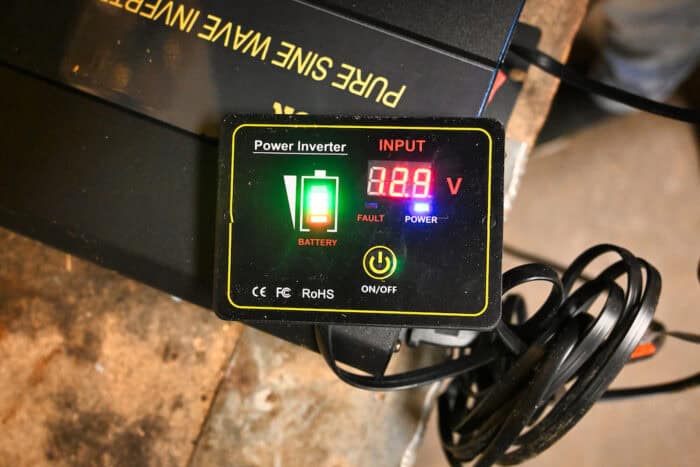
When turned on, the remote shows the same input voltage shown on the inverter display.
This is to track how your battery is doing, and to make sure it’s not discharged down to levels that can permanently damage the battery.
Safety Features
There are six 40A fuses in the inverter that will prevent dangerous events like current spikes.
If the battery is at a low voltage, the inverter beeps to let you know you should not use the inverter again before the battery is recharged.
Besides that, there is a low-voltage shutdown at 9.5V, and an over-temperature protection that kicks in if the internal temperature reaches 176℉ (80℃).
There is also an over-load protection feature. If your devices use over 125% of 2500W (3125W), an alarm will sound. After 20 seconds, the inverter turns off unless you turn off enough devices to drop below 3125W.
Size And Weight
The inverter weighs 9.92 pounds (4.5 kg) and measures 14.96 by 7.09 by 3.54 inches (38 by 18 by 9 cm).
In The Box
Vevor includes six 40A fuses, two battery cables, and a user manual.
The battery cables are 4 gauge, 1.64 ft (50 cm) long and the remote cable is almost 10 ft (3 m).
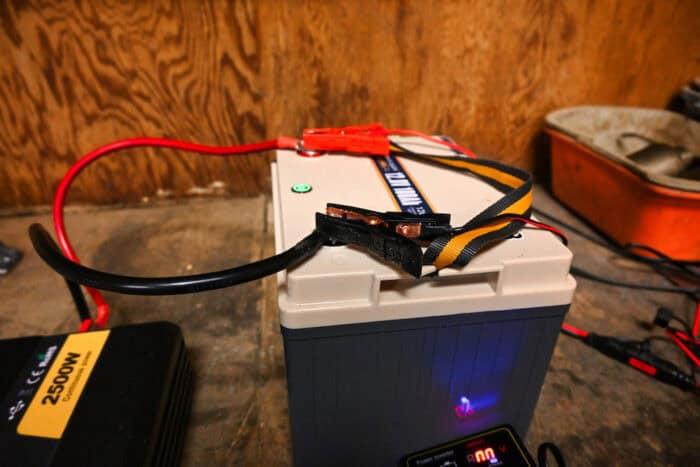
How The Vevor 2500W Inverter Performed In My Tests
The batteries I tested it with
I used the Vevor with both my Power Queen 100Ah lithium battery and a 100Ah AGM battery.
I did not have any issues powering devices via the AC outlets with either of the batteries.
The lithium battery can output up to 100A at 12.8V, so I could not maximize the output with that. Pulling 1300W was not a problem, though.
I have no information on the maximum continuous current for my AGM battery, but I wanted to put the inverter to the test and plugged in several devices until I was pulling 2550W according to the display.
I left it that way over 15 minutes, and the only issues was that the inverter starting beeping because it thought the battery was about to discharge completely.
How is the inverter efficiency?
I tested the inverter efficiency several times, at different currents.
It averaged 90% efficiency. The best result was 92% and the worst was 84%.
I noticed it was the most efficient when I was using between 700-1000W, and the least efficient when I was using 100-200W.
Did the safety features work?
The low-voltage alarm started around 10.5V. If the voltage would have dropped to 9.%, the inverter would’ve turned off itself to protect the battery. It’s also to protect your devices, since the output voltage will drop as the battery voltage drops.
Lead-acid batteries quickly drop in voltage under load, which is why the battery indicator should not be used as the main way to track the state of charge of your batteries.
Does it have an aggressive fan curve? Loud fans?
The fan only turns on when I plug in devices that require more than 1500W for more than a couple of minutes. I was trying to push it to get the fan to turn on, but it was surprising to me how little the fans turned on.
According to Vevor, the intelligent cooling mode turns on the fan when the internal temperature is 113℉ (45℃).
I put my hand on both the inverter and my batteries to make sure they weren’t overheating, but both felt cool to the touch.
A Couple Of Things You Should Know
As I was doing research about this inverter to see what type of experiences others had, I came across some concerning comments.
Reliability issues
According to some reviews, the inverter is not very reliable over time. Since I have only had it for a couple of weeks, I can’t comment on this.
I am not mentioning this just because of one review, but because it seemed like several people had this problem.
Since I am going to keep using this inverter, I will definitely come back and update this review if it decides to die on me in the future.
Questions about how it’s wired
I also came across several users that questioned how the inverter is wired. There were concerns about it not being grounded, and how some AC outlets didn’t work.
I didn’t have any problem powering my devices with one, two, or all three AC outlets at the same time.
This might be something that has been fixed since these reviews were written.
Conclusion
In the intro, there were a couple of questions that I wanted to answer with this review.
Does it work at all? Is it as powerful as they advertise? Did it explode?
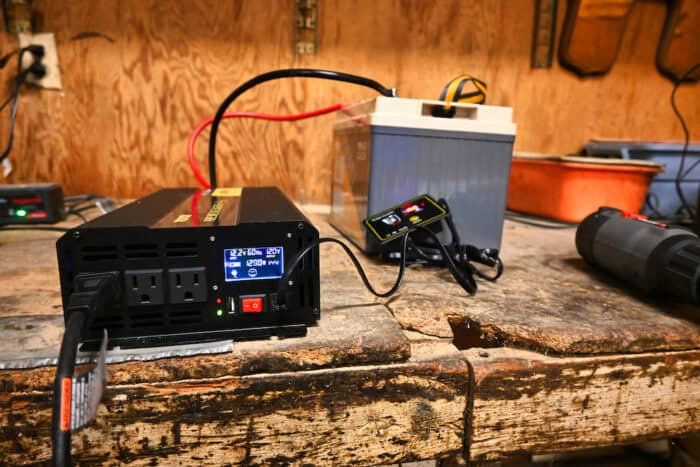
I hope reading this article has answered these questions, but if it didn’t:
The inverter did work for me, and it worked great. I pulled up to 2550W continuously with no problems. What I need to do to prevent the low-voltage alarm is to connect two lithium batteries in parallel to increase the max output current.
It’s as powerful as they say, since I could pull the full 2500W for an extended period.
Also, the inverter is still working and has not exploded!
I recommend the Vevor 2500W if you’re looking for an inverter to power your devices now and then. If you’re taking the RV out to the lake a couple of times every year, it should serve you great.
If you’re a full-time RVer or need an inverter to power your tools in a shop, I would go with a more reputable brand. Nothing against Vevor, but I always recommend going with the more reputable brands for electronics you’re going to be using daily.
Two more reputable brands are Victron and Renogy, but they are going to cost more.
Frequently Asked Questions
What size inverter do I need?
What are you trying to power and for how long? Do you have a battery large enough?
Since inverters are the most efficient when they output about 30-50% of their maximum wattage, it’s a good idea to have an estimate of what your devices are going to be using at most.
Vevor sells larger versions of the model I reviewed, so if you need to power a device that requires 3000W, I recommend getting at least the 3500W version.
You also need to know what the maximum discharge current rating your battery has. If your battery manual states it can output 100A at most, you cannot power devices that require more than about 1200W.
If you’re looking for a small inverter that plugs into a 12V outlet in your vehicle, I recommend reading this article.
Does it support all types of batteries?
It works with 12V batteries. Vevor also sells a model for 24V batteries.
What is the difference between a pure sine wave and a modified one?
Pure sine waves are considered being of higher quality and more suitable for sensitive equipment. Modified since waves can still power most electronics, but not as efficiently.
Can I install this in my RV and connect it to the house battery?
If you have a 12V battery or a 12V configuration, yes. If this is something you’re considering, please leave a comment and tell me what type of battery setup you have.
Also leave a comment if you need help with inverter size suggestions based on your needs. Let me know what you need to power and what batteries you’re going to be using.


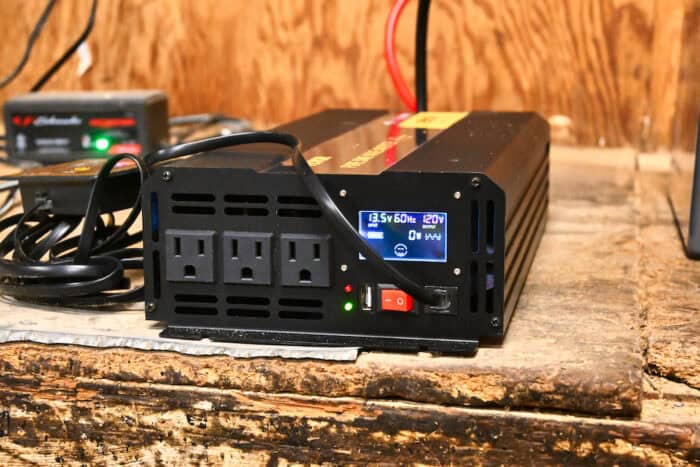
I’m building a barnaminium for my son. We want it all off grid. I’ve been looking at vevor 5000w modified Sign wave Inverter 24v . I have a friend who has the same inverters,but he just got them like two weeks ago. Do you know much about them? And how many can you stack of them?
I just bought one. My cooling fans come on with a 175 watt load, unit is not even warm & don’y shut off. How about yours ?
Hi,
That’s odd unless it’s being used in a very hot place. I have to pull 1500+ for maybe 10 minutes before any fans turn on. Maybe they’ve changed the fan curve to be more aggressive? Mine never gets hot.
Your comment about not being reliable over time is accurate. This inverter uses a high frequency, transformerless design and can only produce its surge rating for a few milliseconds, not seconds. So when it’s used for powering inductive loads like refrigerators, microwaves, AC units and power tools, they typically will have a shorter life due to the damage that these high surge devices do to the inverter’s MOSFET transistors. A much better choice is to spend a little more money and buy a low frequency, transformer based inverter instead. It will last far, far longer and can easily power high inductance loads without being damaged.
Do you have any ideas as to who might make the low frequency transformer based pure sine wave inverter? ……any leads on tracking down such a device would be appreciated…..AB